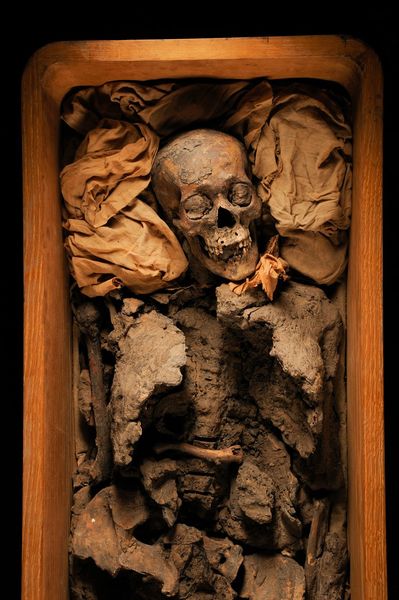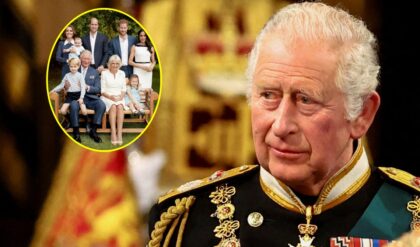Originally buried in WV22 (Valley of the Kings), Amenhotep III’s mummy was moved in ancient times to Tomb KV35, the tomb of Amenhotep II, which was used by Egyptian priests around the Third Intermediate Period as a royal “mummy” cache (storage). Tomb KV35 became a haven to protect the deceased, with priests placing royal mummies from throughout varied reigns together in one space to prevent more damage and theft from ancient tomb robberies.
Despite the rather poorly preserved condition of Amenhotep III’s mummy (only his head is pictured here, but his mummified body does exist alongside his head), modern analysis of the king’s remains tell us he died around aged 50, which matches Grafton Elliot Smith’s estimation from over a century ago; that Amenhotep III’s age at death was likely 40–50 years.
Not much soft tissue remains on the king’s skull, and a few teeth are missing. Rather interestingly; a tooth was found in the oropharynx (throat) of the mummy, however, it is not likely Amenhotep lost these teeth in life, nor did he swallow a tooth. It is almost certain the damage to his teeth and disarray of the tooth in the throat was caused during the mummification process. Other than this, Amenhotep III’s teeth showcase the natural ageing and decay of someone of his age (50 years).
There are, however, “osteoarthritic bony growths” on multiple of the king’s joints, and multiple enthesopathies at the joints of his lower limbs. According to expert analysis, the bones of Amenhotep III do perhaps indicate “Diffuse idiopathic skeletal hyperostosis” (DISH).
Amenhotep III’s mummy showcases the mummification techniques of his time period (18th Dynasty). Eye sockets are packed with “atrophic eye globes”, linen and resin. His torso is packed with resin soaked linens. Despite this traditional technique, his heart is not to be found.
News
Congrats! Miss Nikki Baby Is Expecting Her Second Child With LiAngelo Ball (PHOTO)
The entrepreneur took to internet on July 28 to inform her followers of the exciting news. Miss Nikki — born Nikki Mudarris — posted a picture on Instagram with sheer material draped around her nude body, exposing her growing belly….
“Legal Implications for Diddy: Potential Evidence Explored in Court Proceedings”
“April Lampros Adds to Allegations Against Puff Daddy: New Lawsuit Reveals Disturbing Details April Lampros recently filed the latest in a series of lawsuits against Puff Daddy, bringing the total to eight accusations of sexual assault against the music mogul….
Mel Gibson EXPOSES Oprah’s Questionable Actions For Hollywood Elites ..
“Mel Gibson EXPOSES Oprah’s Questionable Actions For Hollywood Elites”: In a bombshell revelation that has sent shockwaves through the entertainment industry, acclaimed actor and filmmaker Mel Gibson has come forward with explosive allegations against media mogul Oprah Winfrey. Gibson, known…
BREAKING NEWS: Cassie Ventura OFFICIALLY ENDS Diddy’s Career With NEW Video Footage
The Shocking Revelations and Legal Troubles Surrounding Diddy. A recently released video showing Sean “Diddy” Combs physically assaulting his ex-girlfriend, Cassie Ventura, has sparked widespread outrage and reignited discussions about the numerous allegations against the music mogul. The video, obtained…
Joe Budden claps back at Eminem’s disses: “Guess what, I’ve outshined you for an entire decade!”
TҺе ɾаρρеɾ-tuɾ𝚗еԀ-bɾσаԀcаstеɾ wаs ρɾеᴠισusly а mеmbеɾ σf Һιρ-Һσρ ɡɾσuρ SlаuɡҺtеɾҺσusе wιtҺ Rσycе Ԁа 5’9″, Jσеll оɾtιz, а𝚗Ԁ CɾσσƙеԀ I, аs wеll аs ρеɾfσɾmι𝚗ɡ аs а sσlσ аɾtιst. Hе Һаs𝚗’t ɾеlеаsеԀ а𝚗y musιc sι𝚗cе 2016’s ‘Rаɡе & TҺе MаcҺι𝚗е‘ аlbum а𝚗Ԁ…
Snoop Dogg reveals for the first time about his past feud with legendary Eminem: “I felt like I was out of pocket”
In a recent interview, Snoop Dogg candidly addressed his past feud with Eminem, revealing that he has since extended an apology to the rapper. The disagreement arose last year when Snoop expressed his opinion that Eminem did not rank among…
End of content
No more pages to load











